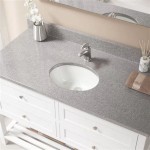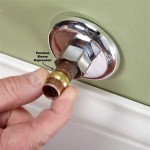Can You Paint Bathroom Sink Faucets in Kitchen? A Comprehensive Guide
The question of whether bathroom sink faucets can be painted for use in the kitchen arises frequently during renovations or aesthetic updates. While painting faucets might seem like a cost-effective and simple solution to refresh their appearance, several factors need consideration to ensure a durable and aesthetically pleasing result. This article will explore the feasibility of painting bathroom sink faucets for kitchen use, the necessary preparations, suitable paint types, potential challenges, and long-term durability considerations.
Bathroom and kitchen faucets often share similar materials and construction, typically consisting of brass, chrome, stainless steel, or zinc alloys. This similarity might lead one to believe painting is a universally viable option. However, the key difference lies in the usage environment and the finish's required durability. Kitchen faucets undergo more frequent handling and exposure to various substances, including grease, detergents, and acidic foods. These factors make a robust and resilient finish essential.
Before embarking on the painting project, a thorough assessment of the faucet's current condition is crucial. This involves identifying any pre-existing damage like scratches, corrosion, or flaking of the existing finish. Addressing these issues is paramount to achieving a smooth and consistent painted surface. Additionally, the type of material the faucet is constructed from will influence the type of primer and paint selected for optimal adhesion.
Understanding Faucet Materials and Their Implications for Painting
The most common materials used in faucet construction are brass, chrome, stainless steel, and zinc alloys. Each material presents unique challenges and requires specific surface preparation techniques to ensure proper paint adhesion. Brass, for example, often has a protective lacquer coating that needs to be completely removed before priming. Chrome, known for its exceptionally smooth and non-porous surface, requires aggressive etching to create a surface profile suitable for primer adhesion.
Stainless steel, while durable and resistant to corrosion, can also be challenging to paint due to its inherent smoothness. Sanding or using a chemical etching primer is essential to promote adhesion. Zinc alloys, often used in lower-cost faucets, might contain imperfections or inconsistencies that need to be addressed before painting. Careful inspection and proper surface preparation are crucial to avoid an uneven or flawed final finish.
Identifying the faucet material is the first step. If unsure, consulting the manufacturer's specifications or performing a simple scratch test in an inconspicuous area can provide valuable insights. A scratch test involves lightly scratching the surface with a sharp object; the color and texture of the material exposed will help determine its composition.
Essential Preparation Steps for Painting Faucets
Proper preparation is the cornerstone of a successful paint job. The first step involves disconnecting the faucet from the plumbing system and thoroughly cleaning it. This removes any surface contaminants like dirt, grease, soap scum, and hard water deposits. Using a degreasing cleaner followed by a thorough rinse with clean water is recommended.
Next, remove any existing finish that is loose or flaking. This can be achieved using sandpaper, wire brushes, or chemical paint strippers. For stubborn finishes, multiple applications of paint stripper might be necessary. Always follow the manufacturer's instructions and wear appropriate personal protective equipment, including gloves and eye protection, when using chemical strippers.
Once the old finish is removed, the faucet surface must be prepared for priming. This typically involves sanding the entire surface to create a slightly roughened texture. Using progressively finer grits of sandpaper, starting with a coarser grit (e.g., 120-grit) and finishing with a finer grit (e.g., 220-grit), will create an optimal surface for primer adhesion. After sanding, thoroughly clean the faucet again to remove any sanding dust.
Masking off any areas that should not be painted, such as threads or internal components, is also crucial. This can be achieved using painter's tape or liquid masking solutions. Precision and attention to detail are essential during this step to ensure a clean and professional-looking final product.
Selecting the Right Primer and Paint for Faucet Finishes
Choosing the appropriate primer and paint is critical for achieving a durable and aesthetically pleasing finish that can withstand the rigors of kitchen use. Specialty primers designed for non-ferrous metals are essential for ensuring proper adhesion. These primers often contain etching agents that chemically bond to the metal surface, creating a strong foundation for the paint.
Epoxy primers are often recommended for their superior adhesion and durability. They provide a robust base coat that resists chipping, scratching, and peeling. Self-etching primers are another viable option, particularly for smooth surfaces like chrome and stainless steel. These primers contain acidic components that etch the surface, creating a profile that promotes paint adhesion.
For the topcoat, consider using epoxy-based paints, two-part polyurethane paints, or specialized appliance paints. These paints are formulated to withstand frequent handling, exposure to moisture, and cleaning agents. Epoxy-based paints offer excellent durability and chemical resistance, making them an ideal choice for kitchen faucets. Two-part polyurethane paints provide a hard, scratch-resistant finish that is also resistant to UV degradation.
Appliance paints are specifically designed for use on appliances and are resistant to heat and moisture. These paints are available in a variety of colors and finishes, including matte, satin, and gloss. When selecting paint, consider the desired aesthetic and the level of durability required. Multiple thin coats of paint are always preferable to a single thick coat, as this minimizes the risk of runs, drips, and uneven coverage.
Spray painting generally provides a smoother and more even finish than brush painting. However, brush painting can be used for smaller areas or when a textured finish is desired. When spray painting, always work in a well-ventilated area and wear a respirator to protect against inhalation of paint fumes.
After painting, allow the faucet to dry and cure completely according to the manufacturer's instructions. This may take several days or even weeks, depending on the type of paint used. Avoid handling the faucet excessively during this period to allow the paint to fully harden and cure. Once the paint is fully cured, the faucet can be carefully reinstalled.
Maintaining the painted faucet involves regular cleaning with mild soap and water. Avoid using abrasive cleaners or scouring pads, as these can damage the painted finish. Regularly inspecting the faucet for signs of chipping or peeling and addressing any issues promptly will help to prolong the lifespan of the painted finish.
Alternatives to painting include replacing the faucet entirely or refinishing it using professional coating services. Replacing the faucet is the most straightforward option, albeit the most expensive. Professional refinishing services offer durable and long-lasting finishes, such as powder coating or electroplating. These services typically involve removing the faucet, preparing the surface, and applying a specialized coating using sophisticated equipment. While more expensive than painting, professional refinishing can provide a finish that is comparable in durability and appearance to a brand-new faucet.
In conclusion, the feasibility of painting bathroom sink faucets for kitchen use is contingent upon meticulous preparation, careful product selection, and a realistic understanding of the finish's performance limitations in a demanding kitchen environment. While painting can provide a temporary aesthetic upgrade, professional refinishing or faucet replacement remains a more reliable and durable option for long-term performance.

The Best Way To Spray Paint A Faucet Average But Inspired

Can You Spray Paint Bathroom Faucets Oh Yes Karins Kottage

Painted Furniture Ideas How To Spray Paint Your Faucet Correctly

Can You Spray Paint Bathroom Faucets Oh Yes Karins Kottage

The Best Way To Spray Paint A Faucet Average But Inspired

How To Paint A Sink It All Started With

How To Paint A Bathroom Faucet Ace Hardware

Can You Spray Paint Bathroom Faucets Oh Yes Karins Kottage

Can You Spray Paint A Bathroom Faucet The Diy Nuts

Paint Bathroom Vanity Countertop Sink So Easy A Piece Of Rainbow
Related Posts






